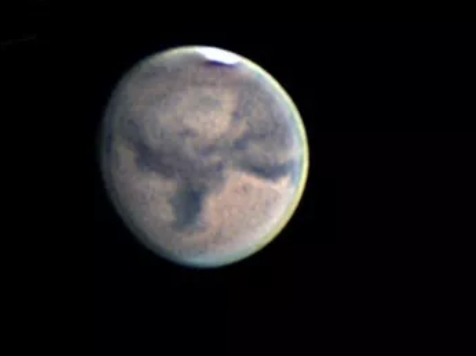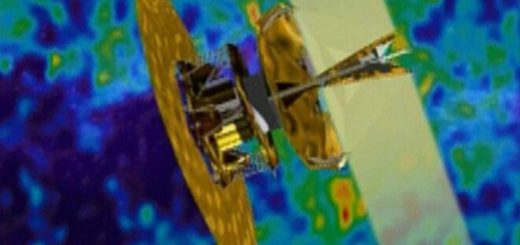You don’t want to miss Mars shining bright this fall

Mars is lighting up the night sky as the planet heads toward an unusually close approach to Earth on Oct. 6.
If you look low in the eastern sky on any clear evening this week, soon after darkness falls, you’ll see a fiery, pumpkin-hued “star” blazing brilliantly. Despite the “Red Planet” moniker, the weeks surrounding Mars’ close approach are a perfect time to appreciate the planet’s true hue, a yellowish orange, the color of a dry desert under a high sun — which is exactly what you’re looking at.
Astronomers use a scale called magnitude to rate the brightness of celestial objects and these days, Mars is shining at an eye-popping magnitude of -2.6. The lower the magnitude, the brighter the object, with stars on the threshold of naked-eye visibility classed as sixth magnitude. The most brilliant objects in the sky have negative magnitudes: Sirius, the brightest star, shines at magnitude -1.4, Venus can peak at -4.8, the full moon is -12.7 and the sun blazes at -26.7.
A topaz beacon
Throughout most of October, Mars and its topaz glow shine brighter than any other object in its region of the sky, except, however, on those nights when the moon is nearby (such as on Oct. 2 and Oct. 29).
Of course, any unusually close approach of Mars to the Earth will make the planet appear exceptionally brilliant and indeed, from now through late November, Mars will easily outshine Sirius and even Jupiter, which is typically the second brightest planet.
On Oct. 13, Mars will reach “opposition,” the moment when the sun, Earth and Mars form a straight line in space. When a planet reaches opposition, it lies exactly opposite from the sun in Earth’s sky: It rises at sunset, reaches its highest point in the sky at midnight, and sets at sunrise.
Imagine the solar system as a giant racetrack. Earth is moving in the inner lane, Mars comes to opposition when the faster-moving Earth overtakes and passes the outer planet. Mars comes to opposition about every 26 months. But because the orbits of both Earth and Mars are elliptical, not all oppositions are created equal.
A stunning opposition
This year’s opposition is particularly promising for skywatchers because Mars recently passed its closest point to the sun, or perihelion, on Aug. 3. That means Mars will approach within less than 40 million miles (64 million kilometers) of Earth. Such “perihelic oppositions,” as they’re called, of Mars are rather infrequent, usually occurring about every 15 to 17 years.
But sometimes Mars can come unusually close to Earth on consecutive oppositions, which last occured in 1986 and 1988. This approach is the second in another pair: Just over 26 months ago, on July 27, 2018, Mars came just 2.78 million miles (4.48 million km) closer to Earth than it will come this year. But for those of us in the Northern Hemisphere, this year’s opposition will make for much better skywatching.
Recent perihelic oppositions saw Mars approach Earth to within 34.9 million miles (56.1 million km) in August 1971, 37.5 million miles (60.4 million km) in July 1986 and 36.5 million miles (58.7 million km) in September 1988. Then, on Aug. 27, 2003 Mars arrived at perihelion just a scant 42 hours after its opposition. This was the closest that Mars approached our planet in nearly 60,000 years: 34.6 million miles (55.7 million km).
A view of Mars on Sept. 25, 2020, as seen from the Philippines.
A view of Mars on Sept. 25, 2020, as seen from the Philippines. (Image credit: Christopher Go)
Prominent for many weeks
Because Earth and Mars follow elliptical orbits around the Sun, Mars’ closest approach to Earth usually occurs several days before or after opposition. Utilizing the United States Naval Observatory’s Multiyear Interactive Computer Almanac (MICA), I found that this year on Oct. 6, Mars will come within 38,568,816 miles (62,070,493 km) of Earth at 10:18 a.m. EDT (1418 GMT). At that moment, it will take a light beam 3 minutes and 27 seconds to cross the interplanetary gulf between Earth and Mars.
Opposition comes a week later, on Oct. 13. And it’s going to be a while until the next opposition brings Mars even closer; that will not occur until Sept. 11, 2035, when the planet will be 35.4 million miles (56.9 million km) away.
Even after Oct. 13, however, Mars’ inevitable fade will start out very slow and gradual. Mars will continue to shine at a magnitude of –2.6 through Oct. 17 and will still outshine Jupiter through Oct. 27. The Red Planet will continue to rival Sirius, the brightest star, until Nov. 20.
The next opposition of Mars will come in early December 2022, but because Mars will then be more than 12 million miles (19 million km) farther from Earth as compared to this month’s extreme opposition, it will appear to shine with just one-half of its current radiance; in telescopes its disc will appear 24% smaller than it does now.
What a difference two years can make!
Skywatchers observing this opposition can take advantage of Mars’ high altitude as compared to two years ago.
Back in July 2018, Mars was in Capricornus the Sea Goat, a constellation that appears low in the southern sky for most people watching from northern locations. Any object that appears less than 30° above the horizon tends to experience atmospheric turbulence; in telescopes the image seems to quiver or “boil,” making it difficult to see surface features.
Your clenched fist held at arm’s length is equal to 10°, and two summers ago, Mars appeared less than “three fists” above the southern horizon, in that region of turbulence. This year’s opposition finds Mars shining in the constellation of Pisces the Fishes, a star pattern that climbs much higher, and Mars will soar about 30° higher in the sky than it did in 2018 — nearly “six fists” high and well above any unstable atmospheric effects.
That makes now a great time to check out Mars in a small telescope. Because it is a relatively small planet (only about twice the size of our moon), it rarely appears very big through a telescope. But now, as it is within close range, you can check it out for yourself. If you have a 3-inch telescope, try using an 80-power eyepiece, which should turn Mars into a sizable disc and bring out some of its darker surface features. Larger apertures will bring even better views. With a 6-inch instrument, you can try 160-power; 12-inches, use 320-power.
In 2018, the poor altitude was compounded by a planet-wide Martian dust storm that obscured virtually everything that might be seen. But this year, so far, no significant dust storms have developed, so visibility across the planet’s disk is excellent.
According to Long Island amateur skywatcher Frank J. Melillo, who regularly observes and photographs the planets from his home in Holtsville, NY: “So far so good! The Martian atmosphere is still free of haze and dust clouds at this moment in time. But who knows? The dust storm might start kicking up the clouds tonight, next week, next month or (hopefully) not this year!”
Take advantage now for, as we noted earlier, Mars won’t be this close again for another 15 years.
Déjà vu all over again
Interestingly, there is a 79-year-long cycle, over which the circumstances of a specific Mars opposition will replicate almost exactly.
On Oct. 3, 1941, for instance, Mars made a close approach to Earth much like this year’s. At its closest that year, Mars was just 414,000 miles (666,000 km) closer to Earth than it will be this Oct. 6.
And 79 years from now, on Oct. 10, 2099, Mars will again make another unusually close approach to Earth, though falling just short of matching this year’s by 400,000 miles (643,000 km).



 Creators of mankind
Creators of mankind Description of “Tall white aliens”
Description of “Tall white aliens” Where they came from?
Where they came from? About hostile civilizations
About hostile civilizations The war for the Earth
The war for the Earth “Tall white aliens” about eternal life
“Tall white aliens” about eternal life Video: “Nordic aliens”
Video: “Nordic aliens” Aliens
Aliens Alien encounters
Alien encounters The aliens base
The aliens base UFO
UFO Technology UFO
Technology UFO Underground civilization
Underground civilization Ancient alien artifacts
Ancient alien artifacts Military and UFO
Military and UFO Mysteries and hypotheses
Mysteries and hypotheses Scientific facts
Scientific facts


















